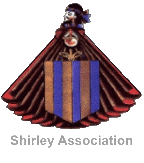

 |
 Tryon Palace Tryon Palace North Carolina |
|
||
| < Back to the Robert Shirley, 1st Earl Ferrers | ||||
|
Lt. Col. William Tryon, his wife and four year old daughter, arrived at Cape Fear North Carolina on October 10, 1764 on the Friendship. William Tryon was the son of Mary Shirley and her husband, Charles Tryon, Esq. of Bulwick in Northampton Co. England. (Mary was the daughter of the First Earl Ferrer by his 2nd marriage. Her son was a first cousin to Lady Huntington who was the daughter of Washington Shirley, 2nd Earl Ferrers). In 1757 William Tryon was commissioned as Captain in the first Regiment of Foot Guards and that same year he was married to Margaret Wake. By the time he reached North Carolina as Lt. Governor in 1764 he was considered an able gentleman. Upon the death of Governor Arthur Dobbs in 1765, Tryon became head of the province. During his six years in this position he experienced both failure and success. The new governor was soon confronted with the introduction of the English Stamp Act, but he was not able to led North Carolinians to accept it. A few years later he was not able to persuade the Regulators from open rebellion against extra taxes and fees which his petty officers were accused of unjustly collecting. He therefore met the distressed countrymen in the Battle of Alamance in 1771 where his trained North Carolina Militia were victorious. Governor Tryon's other undertakings, however were more successful.
|
Governor Tryon was a zealous churchman, he urged the Society for the Propagation of the Gospel to send to North Carolina not the "sweepings of the Universities but some clergy of character" who would promote church progress. He began at once to improve the state's inadequate postal system and to establish better transportation facilities. In 1767 he was able to establish the Cherokee Boundary line which contributed to the orderly settlement of the western North Carolina. At the request of the Presbyterians of Mecklenburg County, he recommended to the General Assembly that it establish "a public seminary in some part of the back country of the Colony for the education of youth". It followed that the state's first institution of higher learning was established (1771) as Queen's College at Charlotte. Whereas former North Carolina governors had found it difficult to get the legislature to appropriate sufficient funds for governmental expenses, Tryon by his clever tact and diplomacy obtained ample money for his various undertakings. He was, therefore, influential in making New Bern the state capital--"a fixed seat of government" where important public records could be collected and preserved. He erected (1767-1770) at New Bern a magnificent structure, the residence of the governor and the first capitol of the colony, now known as Tryon Palace. When the assembly convened in Oct 1769, the resolutions denying the right of Parliament to tax the colonies passed unanimously, with a firm denunciation of the violation of the constitutional rights in Massachusetts where Boston was virtually under martial law. Governor Tryon tried his best to forestall it by announcing at the outset that he had word from London that the ministry was prepared to remove all the taxes except the one on tea. Governor Tryon felt that the action was aimed at him. In Jan 1770 he reported to the Board of Trade that "the proceedings of the last Assembley have wounded my sensibility," and he asked to be considered either for the position of governor of New York or a year's leave of absence. He left North Carolina for New York in 1771. The Royal Governor of New York was exchanging his position as New York Governor for Virginia's Governor. He recommended William Tryon as Governor of New York. Governor William Tryon did became the Governor of New York.. |
|||
|
All Rights Reserved |
||||